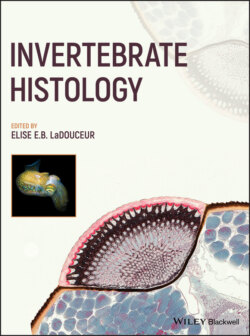Читать книгу Invertebrate Histology - Группа авторов - Страница 14
1.2.1 Keys for Dissection/Processing for Histology
ОглавлениеIn large Asteroidea, gross necropsy is approached from the oral surface. Morphometrics (weight, disc diameter, ray length) can be collected and the animal is placed in dorsal recumbancy. The disc can be opened circumferentially along the junction of the radius/interradius with the body wall, exposing the intestinal tract and gonads (Figure 1.5a). Each ray can be opened along both lateral aspects, removing the ambulacral groove to expose the pyloric cecae, gonads, and internal aspects of the tube feet (ampullae) (Figure 1.5b). Dissection with the animal immersed in sea water (natural or artificial) can help maintain organs in a more natural position and make them easier to assess grossly and dissect. Individual organ samples can be collected into 10% formalin for histology including sections of the body wall. In echinoids, two approaches are possible. The body can be opened circumferentially along the equator of the specimen (Figure. 1.6a) or can be opened dorsal to ventral through the anus and mouth (Figure 1.6b). Holothuroids can be opened with two incisions beginning at the mouth and following along the lateral aspects of the two dorsal ambulacra to the level of the anus. Upon removal of the dorsal aspect of the body wall, the coelomic cavity is readily viewed (Figure 1.7a). It is important to recognize upon opening the animal whether the full complement of viscera is still present as these animals, when stressed, can self‐eviscerate (Figure 1.7b).
Figure 1.5 Gross necropsy image (a) of a bat star (Patiria miniata) open at necropsy. Higher magnification of one of the arms is provided (b) and shows the pyloric cecae (C) and the gonads (G).
Source: Image courtesy of L. Abbo, Marine Biological Laboratory.
Figure 1.6 Gross necropsy images of urchin open at necropsy. Images include a white sea urchin opened at the equator and submerged in sea water (a) and a purple urchin (Arabacia punctulata) opened dorsoventrally (b), showing the gonads (G), digestive tract (D), Aristotle’s latern (A), and ampullae (Am).
Figure 1.7 Gross necropsy images of a California giant sea cucumber opened along the dorsum removing the dorsal ambulacrum. Images include an animal that has not spontaneously eviscerated prior to death (a) and one that has spontaneously eviscerated (b).
Whenever possible, specimens should be fixed and processed for histopathology entire or as cross‐sections as this permits evaluation of the different relationships of various organ systems to one another. Fixation in 10% formalin is adequate for soft tissues but postfixation decalcification of the body wall is required for routine histopathology. Methods of decalcification include fixation in Davidson's solution, postfixation decalcification in EDTA or with formic (DeltaFORM®; CalEx™ II), hydrochloric acid or formic/hydrochloric acid mixes (XL‐Cal®). Decalcification can introduce histologic artifacts into tissues, specifically spaces/clearing in the cellular matrix of the endoskeleton due to gas accumulation. The more aggressive/rapid the decalcification process, the greater the disruption produced. Use of a fixative which has some decalcifying properties, such as Davidson's solution, can reduce the need for postfixation decalcification. In cases where body wall histopathology is the most critical system to be evaluated, plastination at a laboratory that specializes in bone histopathology is recommended to permit processing of fully mineralized tissues. The cuticle is destroyed by fixation in phosphate‐buffered glutaraldehyde but preserved by fixation in sea water‐osmium, seawater‐permanganate, and sea water‐glutaraldehyde, modified Dalton's fixative or in a glutaraldehyde‐osmium sequence with ruthenium red (Holland and Nealson 1978). The latter fixative is most successful in preserving the cuticle in most echinoderms due to the high acid mucopolysaccharide content in most species and the ruthenium red complex.
